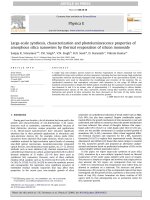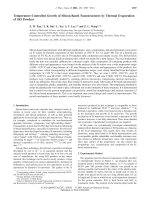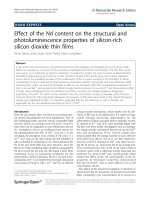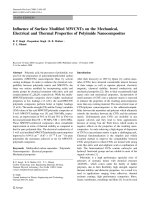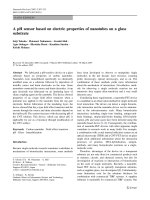Theoretical investigation on thermal properties of silicon based nanostructures
Bạn đang xem bản rút gọn của tài liệu. Xem và tải ngay bản đầy đủ của tài liệu tại đây (7.06 MB, 180 trang )
THEORETICAL INVESTIGATION ON
THERMAL PROPERTIES OF SILICON
BASED NANOSTRUCTURES
CHEN JIE
NATIONAL UNIVERSITY OF SINGAPORE
2011
THEORETICAL INVESTIGATION ON
THERMAL PROPERTIES OF SILICON
BASED NANOSTRUCTURES
CHEN JIE
(M.Sc., Nanjing University)
A THESIS SUBMITTED
FOR THE DEGREE OF DOCTOR OF PHILOSOPHY
DEPARTMENT OF PHYSICS
NATIONAL UNIVERSITY OF SINGAPORE
2011
Dedicated to my wife Chunliu and our parents
THEORETICAL INVESTIGATION ON THERMAL PROPERTIES OF
SILICON BASED NANOSTRUCTURES
Copyright
c
⃝ 2011 by CHEN JIE. All rights reserved.
Department of Physics and Centre for Computational Science & Engineering
Block S12, 2 Science Drive 3
National University of Singapore
Singapore
117542
Email:
ii
Acknowledgements
First and foremost, I would like to express my sincere gratitude to my super-
visor at National University of Singapore, Prof. Li Baowen. This thesis would
not have been possible without his immense knowledge, invaluable guidance and
continuous encouragement throughout the course of my candidature. Meanwhile, I
am extremely grateful to my collaborator Prof. Zhang Gang at Peking University
for his guidance, enthusiasm, patience and numerous discussions. Besides, I also
want to thank Prof. Wang Jian-Sheng at National University of Singapore for
many helpful discussions.
In addition, I want to acknowledge the financial support from President’s
Graduate Fellowship during my candidature.
I am also grateful to many group members and friends in Singapore for their
help: Dr. Lan Jinghua, Dr. Tang Yunfei, Dr. Zhang Qi, Dr. Zhou Jie, Dr. Li
Nianbei, Dr. Jiang Jin-Wu, Dr. Yang Nuo, Dr. Wu Xiang, Mr. Yao Donglai, Mr.
Zhang Lifa, Ms. Zhu Guimei, Ms. Zhang Kaiwen, Ms. Shi Lihong, Mr. Liu Sha,
Mr. Zhang Xun, Ms. Ma Jing, to name a few.
Finally, I would like to express my deepest gratitude to my wife Chunliu and
our parents. I am always indebted for their generous support, encouragement,
tolerance and love.
iii
Table of Contents
Acknowledgements iii
Abstract viii
List of Publications x
List of Tables xii
List of Figures xiii
1 Introduction 1
1.1 Semiconductor Nanowires . . . . . . . . . . . . . . . . . . . . . . . 2
1.1.1 Background . . . . . . . . . . . . . . . . . . . . . . . . . . . 2
1.1.2 Experimental Synthesis . . . . . . . . . . . . . . . . . . . . . 3
1.1.3 Silicon Nanowires . . . . . . . . . . . . . . . . . . . . . . . . 5
iv
1.2 Thermoelectrics . . . . . . . . . . . . . . . . . . . . . . . . . . . . . 10
1.2.1 Thermoelectric Effect and Application . . . . . . . . . . . . 10
1.2.2 Efficiency and Challenge . . . . . . . . . . . . . . . . . . . . 12
1.2.3 Recent Advance . . . . . . . . . . . . . . . . . . . . . . . . . 14
1.3 Thesis Outline . . . . . . . . . . . . . . . . . . . . . . . . . . . . . . 21
2 Simulation Methods 23
2.1 Brief Introduction to Molecular Dynamics . . . . . . . . . . . . . . 24
2.2 Stillinger-Weber Potential . . . . . . . . . . . . . . . . . . . . . . . 27
2.3 Velocity Verlet Algorithm . . . . . . . . . . . . . . . . . . . . . . . 29
2.4 Non-equilibrium Molecular Dynamics . . . . . . . . . . . . . . . . . 30
2.4.1 Background . . . . . . . . . . . . . . . . . . . . . . . . . . . 30
2.4.2 Effect of Heat Bath . . . . . . . . . . . . . . . . . . . . . . . 34
2.4.3 Summary . . . . . . . . . . . . . . . . . . . . . . . . . . . . 47
2.5 Equilibrium Molecular Dynamics . . . . . . . . . . . . . . . . . . . 47
2.5.1 Green-Kubo Formula . . . . . . . . . . . . . . . . . . . . . . 47
2.5.2 Overview of Different Implementations . . . . . . . . . . . . 51
2.5.3 Improvement of Accuracy . . . . . . . . . . . . . . . . . . . 53
v
2.5.4 Summary . . . . . . . . . . . . . . . . . . . . . . . . . . . . 69
2.6 Brief Introduction to Lattice Dynamics . . . . . . . . . . . . . . . . 69
3 Tunable Thermal Conductivity of Si
1−x
Ge
x
Nanowires 75
3.1 Motivation . . . . . . . . . . . . . . . . . . . . . . . . . . . . . . . . 76
3.2 Si/Ge Randomly Doped Nanowires . . . . . . . . . . . . . . . . . . 77
3.3 Si/Ge Superlattice Nanowires . . . . . . . . . . . . . . . . . . . . . 82
3.4 Summary . . . . . . . . . . . . . . . . . . . . . . . . . . . . . . . . 87
4 Remarkable Reduction of Thermal Conductivity in Si Nanotubes 88
4.1 Motivation . . . . . . . . . . . . . . . . . . . . . . . . . . . . . . . . 89
4.2 Thermal Conductivity of Si Nanotubes . . . . . . . . . . . . . . . . 90
4.3 Phonon Mode Analysis . . . . . . . . . . . . . . . . . . . . . . . . . 97
4.4 Summary . . . . . . . . . . . . . . . . . . . . . . . . . . . . . . . . 101
5 Phonon Coherent Resonance in Core-Shell Nanowires 103
5.1 Motivation . . . . . . . . . . . . . . . . . . . . . . . . . . . . . . . . 104
5.2 Oscillation in Heat Current Autocorrelation Function . . . . . . . . 105
5.3 Coupling Picture . . . . . . . . . . . . . . . . . . . . . . . . . . . . 115
5.4 Coherent Mechanism to Tune Thermal Conductivity . . . . . . . . 118
vi
5.5 Summary . . . . . . . . . . . . . . . . . . . . . . . . . . . . . . . . 123
6 A Universal Gauge for Thermal Conductivity of Si Nanowires 125
6.1 Motivation . . . . . . . . . . . . . . . . . . . . . . . . . . . . . . . . 126
6.2 Universal Gauge Above Threshold . . . . . . . . . . . . . . . . . . . 127
6.3 Deviation Below Threshold . . . . . . . . . . . . . . . . . . . . . . . 134
6.4 Discussion and Summary . . . . . . . . . . . . . . . . . . . . . . . . 140
7 Conclusions 142
7.1 Contribution . . . . . . . . . . . . . . . . . . . . . . . . . . . . . . . 142
7.2 Future Work and Outlook . . . . . . . . . . . . . . . . . . . . . . . 145
Bibliography 148
vii
Abstract
With the continuous decrease of fossil fuel supplies but increasing demand for
energy in the world, thermoelectrics has attracted wide attention in recent years
due to its ability to provide sustainable energy harvested from wasted heat. It
has been challenging to increase the thermoelectric efficiency over the past five
decades, until very recently exciting progresses have been achieved in this field by
using semiconductor nanostructures. These recent advances are achieved mainly
due to the significant reduction of thermal conductivity in these low-dimensional
materials. This thesis is devoted to search for various strategies that can effectively
reduce thermal conductivity of semiconductor nanostructures, which is of great
interest to further enhance the thermoelectric efficiency.
To begin with, we discuss some critical aspects of molecular dynamics simula-
tions, which are used in this study to investigate the thermal properties of silicon
based nanostructures. Using silicon nanowires (SiNWs) and silicon-germanium
nanojunctions as examples, we study the effect of heat bath on calculated ther-
mal properties in non-equilibrium molecular dynamics simulations. In addition,
we examine different implementations of Green-Kubo formula and discuss how to
improve the accuracy of thermal conductivity calculations in equilibrium molecular
viii
dynamics simulations.
In the second part, we demonstrate through molecular dynamics simulations
various strategies that can effectively reduce thermal conductivity of SiNWs, in-
cluding random doping, superlattice and hollow nanostructure. These approaches
belong to the incoherent mechanisms that reduce thermal conductivity by enhanc-
ing the phonon scattering rate. Moreover, we discuss in core-shell NWs an in-
triguing oscillation effect in heat current autocorrelation function, while the same
effect is absent in pure silicon nanowires, nanotube structures and randomly doped
nanowires. Detailed characterizations of the oscillation signal reveal that this in-
triguing oscillation is caused by the coherent resonance effect of the transverse and
longitudinal phonon modes, which offers a coherent mechanism to tune thermal
conductivity in core-shell NWs.
Finally, we study thermal conductivity of SiNWs with different cross sectional
geometries. Interestingly, a universal linear dependence of thermal conductivity on
surface-to-volume ratio is found in SiNWs with modest cross sectional area larger
than about 20 nm
2
(threshold), regardless of the specific cross sectional geometry.
This offers a simple approach to tune thermal conductivity by geometry. Moreover,
the physical mechanisms that cause the deviation from the universal linear relation
for very thin SiNWs below the threshold are also discussed.
ix
List of Publications
[1] J. Chen, G. Zhang, and B. Li, “A universal gauge for thermal conductivity of
silicon nanowires with different cross sectional geometries”, J. Chem. Phys. 135,
204705 (2011).
[2] J. Chen, G. Zhang, and B. Li, “Phonon coherent resonance and its effect on
thermal transport in core-shell nanowires”, J. Chem. Phys. 135, 104508 (2011).
[3] J. Chen, G. Zhang, and B. Li, “Remarkable Reduction of Thermal Conductivity
in Silicon Nanotubes”, Nano Lett. 10, 3978 (2010).
[4] J. Chen, G. Zhang, and B. Li, “How to improve the accuracy of equilibrium
molecular dynamics for computation of thermal conductivity?”, Phys. Lett. A
374, 2392 (2010).
[5] J. Chen, G. Zhang, and B. Li, “Molecular Dynamics Simulations of Heat Con-
duction in Nanostructures: Effect of Heat Bath”, J. Phys. Soc. Jpn. 79, 074604
(2010).
[6] J. Chen, G. Zhang, and B. Li, “Tunable thermal conductivity of Si
1−x
Ge
x
nanowires”, Appl. Phys. Lett. 95, 073117 (2009).
x
[7] L. Shi, J. Chen, G. Zhang, and B. Li, “Thermoelectric Figure of Merit in Ga-
Doped [0001] ZnO Nanowires”, Submitted.
[8] J. -W. Jiang, J. Chen, J. -S. Wang, and B. Li, “Edge states induce boundary
temperature jump in molecular dynamics simulation of heat conduction”, Phys.
Rev. B 80, 052301 (2009).
xi
List of Tables
2.1 EMD simulation results for thermal conductivity of crys-
talline silicon at 1000 K. . . . . . . . . . . . . . . . . . . . . . . 62
3.1 The fitting parameters of thermal conductivity for both
Langevin and Nos´e-Hoover heat bathes. . . . . . . . . . . . . 80
xii
List of Figures
1.1 In situ TEM images recorded during the process of Ge
nanowires growth. Adapted from Ref. [7]. . . . . . . . . . . . . . 4
1.2 Thermoelectric module for both cooling and power gener-
ation. Adapted from Ref. [49]. . . . . . . . . . . . . . . . . . . . . 11
1.3 Thermoelectric properties versus carrier concentration. Adapted
from Ref. [51]. . . . . . . . . . . . . . . . . . . . . . . . . . . . . . . 13
1.4 Thermoelectric figure of merit as a function of temperature
and year illustrating important milestones. Adapted from
Ref. [52]. . . . . . . . . . . . . . . . . . . . . . . . . . . . . . . . . . 15
1.5 Measured thermal conductivity of individual SiNWs with
different diameters. Adapted from Ref. [55]. . . . . . . . . . . . 16
1.6 Measured thermal conductivity of rough SiNWs with dif-
ferent diameters. Adapted from Ref. [44]. . . . . . . . . . . . . . 17
xiii
1.7 Thermoelectric properties of rough SiNWs versus temper-
ature. Adapted from Ref. [44]. . . . . . . . . . . . . . . . . . . . . 18
1.8 Device geometries and thermal conductivity measurements.
Adapted from Ref. [58]. . . . . . . . . . . . . . . . . . . . . . . . . 20
2.1 Schematic picture for NEMD simulation of SiNWs. . . . . . 32
2.2 Temperature profile of SiNWs in NEMD simulation. . . . . 33
2.3 Impacts of the number of heat bath layers on thermal prop-
erties of SiNWs. . . . . . . . . . . . . . . . . . . . . . . . . . . . 36
2.4 Normalized autocorrelation function of velocity in different
heat bathes. . . . . . . . . . . . . . . . . . . . . . . . . . . . . . . 39
2.5 Temperature profile with different number of layers of Berend-
sen heat bath. . . . . . . . . . . . . . . . . . . . . . . . . . . . . . 40
2.6 Impacts of heat bath parameter on thermal properties of
SiNWs. . . . . . . . . . . . . . . . . . . . . . . . . . . . . . . . . . 42
2.7 J
±
in Si/Ge nanojunctions versus heat bath parameters. . . 46
2.8 Time dependence of normalized heat current autocorrela-
tion function based on different definitions of heat current. 56
xiv
2.9 Time dependence of normalized heat current autocorrela-
tion function Cor(t)/Cor(0), relative fluctuation of Cor(t),
and accumulative thermal conductivity κ
a
for two typical
realizations in a 4 × 4 × 4 super cell. . . . . . . . . . . . . . . 58
2.10 Calculated thermal conductivity versus super cell size from
different methods with first avalanche at 1000 K. . . . . . . 61
2.11 Raw data and the corresponding fitted curve according
to double exponential fitting of the normalized heat cur-
rent autocorrelation function before the cut-off time for
the same two realizations shown in Fig. 2.9. . . . . . . . . . . 66
2.12 Typical participation ratio for bulk Si and SiNWs. . . . . . 74
3.1 Normalized thermal conductivity of Si
1−x
Ge
x
NWs versus
Ge content at 300 K. . . . . . . . . . . . . . . . . . . . . . . . . 79
3.2 Averaged phonon participation ratio versus Ge content in
Si
1−x
Ge
x
NWs. . . . . . . . . . . . . . . . . . . . . . . . . . . . . 81
3.3 Schematic picture for Si/Ge superlattice nanowires. . . . . . 83
3.4 Thermal conductivity κ of Si/Ge superlattice NWs versus
period length at 300 K. . . . . . . . . . . . . . . . . . . . . . . . 84
xv
3.5 Normalized power spectrum of different atoms in Si/Ge
superlattice NWs. . . . . . . . . . . . . . . . . . . . . . . . . . . 86
3.6 Overlap ratio of power spectrum versus period length. . . . 87
4.1 A typical cross sectional view of SiNTs. . . . . . . . . . . . . 90
4.2 Heat current autocorrelation function and thermal conduc-
tivity of SiNWs. . . . . . . . . . . . . . . . . . . . . . . . . . . . 92
4.3 Thermal conductivity of SiNWs and SiNTs versus cross
section area at 300 K. . . . . . . . . . . . . . . . . . . . . . . . . 94
4.4 Thermal conductivity of SiNWs and SiNTs versus temper-
ature. . . . . . . . . . . . . . . . . . . . . . . . . . . . . . . . . . . 96
4.5 Participation ratio of each eigen-mode for SiNTs and SiNWs
with the same cross section area. . . . . . . . . . . . . . . . . . 98
4.6 Normalized energy distribution on the cross section plane
of SiNWs and SiNTs at 300 K. . . . . . . . . . . . . . . . . . . 100
5.1 Cross sectional view of [100] Ge/Si core-shell NWs. . . . . . 105
5.2 Lattice constant of Ge/Si core-shell NWs versus core-shell
ratio calculated after structure relaxation. . . . . . . . . . . . 106
xvi
5.3 Time dependence of normalized heat current autocorrela-
tion function. . . . . . . . . . . . . . . . . . . . . . . . . . . . . . 108
5.4 Long-time region of normalized HCACF for different core-
shell NWs. . . . . . . . . . . . . . . . . . . . . . . . . . . . . . . . 109
5.5 Structure and temperature dependence of the oscillation
effect in Ge/Si core-shell NWs. . . . . . . . . . . . . . . . . . . 111
5.6 Amplitude of the fast Fourier transform of the long-time
region of normalized HCACF. . . . . . . . . . . . . . . . . . . . 114
5.7 Coupling strength versus core-shell ratio in Ge/Si core-shell
NWs. . . . . . . . . . . . . . . . . . . . . . . . . . . . . . . . . . . 118
5.8 Averaged phonon participation ratio versus core-shell ratio
in Ge/Si core-shell NWs. . . . . . . . . . . . . . . . . . . . . . . 119
5.9 Structure dep endence of thermal conductivity in Ge/Si core-
shell NWs with different cross section areas at 300 K. . . . 121
5.10 Temperature dependence of thermal conductivity reduc-
tion in Ge/Si core-shell NWs. . . . . . . . . . . . . . . . . . . . 122
6.1 Cross sectional view of the ideal geometry and actual lattice
structure of [100] SiNWs. . . . . . . . . . . . . . . . . . . . . . 128
xvii
6.2 Thermal conductivity of [100] SiNWs versus surface-to-
volume ratio at different temperature. . . . . . . . . . . . . . 130
6.3 Normalized thermal conductivity of SiNWs versus temper-
ature for different cross sectional geometries. . . . . . . . . . 133
6.4 Averaged phonon participation ratio versus surface-to-volume
ratio in SiNWs. . . . . . . . . . . . . . . . . . . . . . . . . . . . . 135
6.5 Normalized energy distribution for the localized phonon
modes on the cross sectional plane of SiNWs with large
cross sectional area at 300 K. . . . . . . . . . . . . . . . . . . . 137
6.6 Normalized energy distribution for the localized phonon
modes on the cross sectional plane of SiNWs with small
cross sectional area at 300 K. . . . . . . . . . . . . . . . . . . . 139
xviii
Chapter 1
Introduction
In this chapter, we introduce the background of the present study, includ-
ing semiconductor nanowires and thermoelectrics. The field of semiconductor
nanowires is one of the most active research areas in recent years. Semicon-
ductor nanowires provide a unique platform to explore interesting phenomena at
nanoscale, and are expected to play a critical role in future electronic, optoelec-
tronic and thermoelectric devices. In this chapter, some aspects of the research re-
garding semiconductor nanowires, including experimental synthesis process, phys-
ical prop erties and potential applications, are reviewed, with emphasis on silicon
nanowires. Moreover, the basic principles and applications of thermoelectric ef-
fect are discussed. The challenges and recent advances in thermoelectrics are also
reviewed. Finally, the outline of this thesis is presented.
1
Chapter 1. Introduction
1.1 Semiconductor Nanowires
1.1.1 Background
Low dimensional nanostructures have attracted much attention in the last
two decades, since the experimental synthesis of carbon nanotubes (CNTs) by
Iijima [1] in the early 1990s. From the fundamental physics point of view, they
are of great interest because they can serve as a unique platform to probe certain
intriguing physical phenomena. For instance, Brandbyge et al. [2] studied the
electrical conductance of Au nanowires in experiment based on measurements with
scanning tunneling microscope. Their experimental results have shown clear signs
of electrical conductance quantization in the unit of 2e
2
/h, which e is the charge
of electron and h is the Planck constant. Moreover, Hu et al. [3] have observed
the Coulomb blockade effect in silicon nanowires at room temperature, which is
encouraging for the application of single-electron transistors (SETs).
In addition to the physical interest, low dimensional nanostructures are also
important in industry to sustain the historical scaling trend beyond the comple-
mentary metal-oxide-semiconductor (CMOS). Novel one-dimensional (1D) nanos-
tructures, including CNTs and semiconductor nanowires, have been proposed as
the building blocks in future nanoscale devices and circuits. CNTs are constructed
by rolling up graphene sheet. One unique feature of CNTs is that their electronic
structure can be either metallic or semiconducting, depending on the exact way
that they are wrapped up (chirality) [4]. On the one hand, this unique property
makes CNTs very interesting materials with richer physics, and thus great efforts
have been devoted to the field of CNTs. On the other hand, it has also hindered
the applications of CNTs based devices because of the difficulties to synthesize
2
Chapter 1. Introduction
uniform semiconducting CNTs in experiment [5].
Compared with CNTs, semiconductor nanowires can be synthesized with re-
producible electronic properties in high-yield, which is usually required for large
scale commercial applications. In addition, the well-controlled nanowire growth
technique facilitates that materials with distinct chemical composition, structure,
size and morphology can be integrated [6]. With such an ability, it may lead to the
bottom-up assembly of integrated circuits [6], which has the advantage of parallel
production of massive number of devices with similar material properties.
1.1.2 Experimental Synthesis
Semiconductor nanowires are usually synthesized by using metal nanoclusters
as catalysts via the vapour-liquid-solid (VLS) process. Fig. 1.1 shows the in situ
transmission electron microscopy (TEM) images during the synthesis process of Ge
nanowires adapted from Ref. [7]. In the VLS process, the metal nanoclusters are
first heated above the eutectic temperature for the metal-semiconductor system of
interest with the vapour-phase source of the semiconductor. The semiconductor
reactant is then continuously fed into the liquid droplet, giving rise to the su-
persaturation of the eutectic and the nucleation of the solid semiconductor. The
solid-liquid interface acts as a sink causing the continued semiconductor incorp o-
rating into the lattice and the growth of nanowire with the alloy droplet riding on
the top.
The gaseous semiconductor reactants can be generated through the decom-
position of precursors in a chemical vapour deposition (CVD) process, or through
the momentum and energy transfer methods, such as pulsed laser ablation [8] or
molecular beam epitaxy (MBE) [9] from solid targets. So far, CVD has been
3
Chapter 1. Introduction
Figure 1.1: In situ TEM images recorded during the process of Ge
nanowires growth. a Au nanoclusters in solid state at 500
◦
C. b Alloying initi-
ates at 800
◦
C, at this stage Au exists mostly in solid state. c Liquid Au/Ge alloy.
d Nucleation of Ge nanocrystal on the alloy interface. e Ge nanocrystal elongates
with further Ge condensation and eventually forms a nanowire in f. Adapted from
Ref. [7].
the most popular technique. In CVD-VLS growth technique, the metal nanoclus-
ter serves as the catalyst where the gaseous precursor decompose, providing the
gaseous semiconductor reactants. For instance, in the growth process of silicon
nanowires, silane (SiH
4
) and Au nanoparticles are usually used as the precursor
and catalysts, respectively. Uniform nanowires with negligible diameter variation
can be achieved through careful control of the growth conditions, including the use
of local heaters to reduce uncontrolled decomposition of silane [10]. The diameter
4
Chapter 1. Introduction
of the nanowire is determined by that of the starting nanocluster. Uniform and
atomic-scale nanowires can be synthesized in a well controlled growth process as
nanoclusters with diameters down to a few nanometers are now available [11].
Compared with other approaches to fabricate nanostructures, the VLS tech-
nique has one important advantage: it is possible to synthesize heterostructures at
the individual device level in a controlled fashion. Both radial heterostructures, in
which core-shell structure form along the radial direction [12–14], and axial het-
erostructures, in which sections of different materials with the same diameter such
as superlattice structure are grown along the wire axis [15, 16], have been realized
by using VLS growth technique. The VLS technique has now become a widely
used method for producing 1D nanostructures from a rich variety of pure and
doped inorganic materials that include elemental semiconductors (Si, Ge) [7, 11],
III-V semiconductors (GaN, GaAs, GaP, InP, InAs) [17–21], II-VI semiconductors
(ZnS, ZnSe, CdS, CdSe) [22–24]. Interested readers can refer to the experimen-
tal review by Lu and Lieber [5] for more details about the growth technique of
semiconductor nanowires.
1.1.3 Silicon Nanowires
Among various semiconductor nanowires, silicon nanowires (SiNWs) have been
the focus of recent studies due to the wide abundance, low cost, and high compat-
ibility to the well developed Si-based semiconductor industry. Due to the presence
of surface dangling bonds, the average coordination number of SiNWs is lower
than that of bulk Si. These surface dangling bonds make the surface atoms highly
reactive and induce surface reconstructions, which can minimize the Wulff energy
in pristine SiNWs [25]. In experiment, the surface of SiNWs is usually passivated
5

